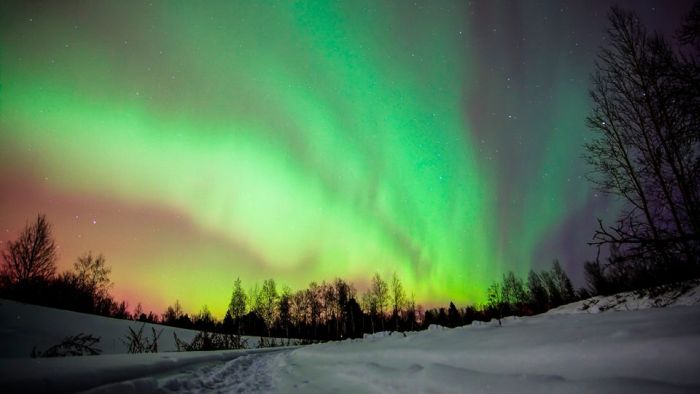|
|
Aurora, Amazing Northern Lights
|
Bright auroras are generally associated with Birkeland currents (Schield et al., 1969; Zmuda and Armstrong, 1973) which flow down into the ionosphere on one side of the pole and out on the other. In between, some of the current connects directly through the ionospheric E layer (125 km); the rest ("region 2") detours, leaving again through field lines closer to the equator and closing through the "partial ring current" carried by magnetically trapped plasma. The ionosphere is an ohmic conductor, so such currents require a driving voltage, which some dynamo mechanism can supply. Electric field probes in orbit above the polar cap suggest voltages of the order of 40,000 volts, rising up to more than 200,000 volts during intense magnetic storms.
Ionospheric resistance has a complex nature, and leads to a secondary Hall current flow. By a strange twist of physics, the magnetic disturbance on the ground due to the main current almost cancels out, so most of the observed effect of auroras is due to a secondary current, the auroral electrojet. An auroral electrojet index (measured in nanotesla) is regularly derived from ground data and serves as a general measure of auroral activity.
However, ohmic resistance is not the only obstacle to current flow in this circuit. The convergence of magnetic field lines near Earth creates a "mirror effect" that turns back most of the down-flowing electrons (where currents flow upwards), inhibiting current-carrying capacity. To overcome this, part of the available voltage appears along the field line ("parallel to the field"), helping electrons overcome that obstacle by widening the bundle of trajectories reaching Earth; a similar "parallel potential" is used in "tandem mirror" plasma containment devices. A feature of such voltage is that it is concentrated near Earth (potential proportional to field intensity; Persson, 1963), and indeed, as deduced by Evans (1974) and confirmed by satellites, most auroral acceleration occurs below 10,000 km. Another indicator of parallel electric fields along field lines are beams of upwards flowing O+ ions observed on auroral field lines.
Some O+ ions ("conics") also seem accelerated in different ways by plasma processes associated with the aurora. These ions are accelerated by plasma waves, in directions mainly perpendicular to the field lines. They therefore start at their own "mirror points" and can travel only upwards. As they do so, the "mirror effect" transforms their directions of motion, from perpendicular to the line to lying on a cone around it, which gradually narrows down.
|
|









